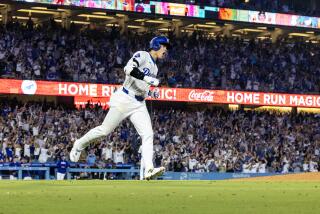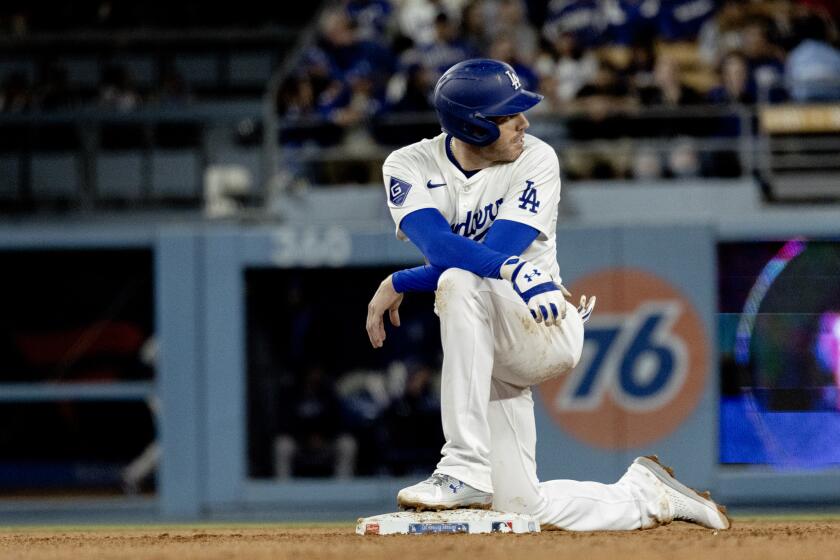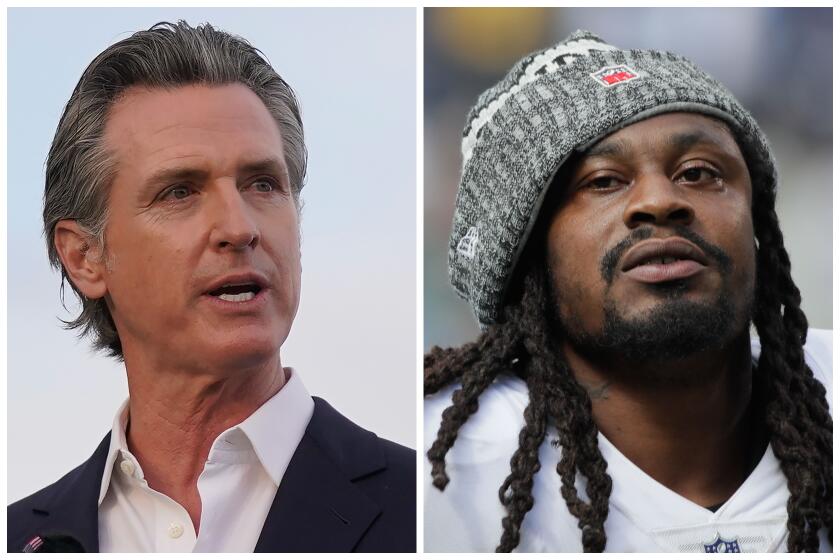Pitcher Perfect : 25 Years Ago Tonight, Koufax Mowed Down All 27 Cubs to Make His Fourth No-Hitter Even More Special
Three times in his sensational career has Sandy Koufax walked out to the mound to pitch a fateful ninth, where he turned in a no-hitter. But tonight, September the ninth, nineteen hundred and sixty-five, he made the toughest walk of his career, I’m sure, because through eight innings, he has pitched a perfect game. He has struck out 11, he has retired 24 consecutive batters and the first man he will look at is catcher Chris Krug. . . .
--Vin Scully
Twenty-five years ago tonight, Glenn Beckert of the Chicago Cubs struck out in his first at-bat against Dodger pitcher Sandy Koufax, but only after his screaming liner down the left-field line had landed a few inches foul.
Returning to the visitors’ dugout at Dodger Stadium, the rookie second baseman was stopped by teammate Ron Santo, who gestured toward Koufax.
“What’s he got tonight?”
Answered Beckert: “Nothing. He ain’t got nothing. We should be able to get to him tonight.”
A seer, Beckert was not.
Koufax, described by a Times reporter as “a Michelangelo among pitchers,” had taken hammer to chisel and carved out the beginnings of his masterpiece.
When his work was complete, he had retired 27 consecutive batters--14 by strikeout--pitching a perfect game and beating the Cubs, 1-0, in perhaps the most dominant performance of his Hall of Fame career.
“I would think the last two or three innings, that’s as well as I ever pitched,” Koufax said recently. “Earlier in the game, I didn’t have great stuff. I was just getting people out. But the last two innings were probably as good as I ever pitched.”
The stylish left-hander struck out eight of the last 10 batters, including the last six. Only Beckert and Byron Browne, who lined out to center fielder Willie Davis in the second inning, hit the ball solidly.
It was the “most memorable moment” in Los Angeles Dodger history, according to a poll of fans conducted by the Dodgers during the 1975 season.
The game was noteworthy not only because of Koufax’s dominance, but also because Cub pitcher Bob Hendley almost equaled the feat of his more celebrated foe.
Hendley pitched a one-hitter, giving up only a bloop double by Lou Johnson in the seventh inning that did not figure in the scoring.
Said Hendley, a left-hander whose 48-52 record in seven major league seasons included six shutouts: “That was the most recognizable thing I ever did in baseball, and I came out a loser.”
Hendley and the Cubs were in the wrong place at the wrong time.
. . . And Koufax ready and delivers. Curveball for a strike.
Oh-and-one the count to Chris Krug. Out on deck to pinch-hit is one of the men we mentioned earlier as a possible, Joey Amalfitano.
Here’s the strike - 1 pitch to Krug: Fastball, swung on and missed. Strike 2.
And you can almost taste the pressure now. Koufax lifted his cap, ran his fingers through his black hair, then pulled the cap back down, fussing at the bill. Krug must feel it, too, as he backs out, heaves a sigh, took off his helmet, put it back on and steps back up to the plate. Tracewski is over to his right to fill up the middle. Kennedy is deep to guard the line.
The strike - 2 pitch on the way: Fastball, outside. Ball 1.
Krug started to go after it and held up. And Torborg held the ball high in the air, trying to convince Vargo, but Eddie said, ‘No, sir.’ One-and-two the count to Chris Krug. It is 9:41 p.m. on September the ninth.
The 1-2 pitch on the way: Curveball, tapped foul off to the left of the plate.
The Dodgers defensively in this spine-tingling moment: Sandy Koufax and Jeff Torborg; the boys who will try and stop anything hit their way--Wes Parker, Dick Tracewski, Maury Wills and John Kennedy; the outfield of Lou Johnson, Willie Davis and Ron Fairly. And there’s 29,000 people in the ballpark and a million butterflies--29,139 paid.
Koufax into his windup and the 1-2 pitch: Fastball, fouled back, out of play.
In the Dodger dugout, Al Ferrara gets up and walks down near the runway. And it begins to get tough to be a teammate and sit in the dugout and have to watch. Sandy back of the rubber, now toes it; all the boys in the bullpen straining to get a better look as they look through the wire fence in left field. One and two the count to Chris Krug.
Koufax, feet together, now to his windup, and the 1-2 pitch: Fastball, outside. Ball 2.
A lot of people in the ballpark now are starting to see the pitches with their heart. The pitch was outside; Torborg tried to pull it over the plate. But Vargo, an experienced umpire, wouldn’t go for it. Two-and-two the count to Chris Krug.
Sandy, reading signs, into his windup, 2-2 pitch: Fastball, got him swinging. . . .
A rookie catcher from Riverside, Chris Krug had hoped to redeem himself as he batted in the ninth. His throwing error had allowed the Dodgers to score in the fifth.
In a rally typical of the light-hitting Dodgers of that era, they scored without benefit of a hit.
Leading off the inning, Johnson drew Hendley’s only walk. Sacrificed to second by Ron Fairly, Johnson then stole third and kept on running when Krug’s throw sailed into left field.
“I never should have thrown it,” Krug said. “Lou had it beat. I threw the ball and Ron (Santo) had to jump for it and Lou knocked his feet out from under him.”
Johnson, though, said that Krug wasn’t to blame.
“It was a good throw,” he said. “Santo didn’t get there. I surprised everybody. That’s the name of the game in stealing--surprise.”
Said Hendley: “Don’t blame (Krug). He didn’t put him on. I put him on.”
Hendley paid for it, too, gaining recognition not for his one-hitter, but as a footnote to a night of perfection by Koufax.
“There was nobody who was going to hit Sandy Koufax that day,” Santo said. “He just kept throwing fastballs right by you. It was just one of those games where you were just overmatched.”
Joey Amalfitano, a Cub reserve, was in the clubhouse when the game started. Walking down the tunnel to the dugout in the first inning, he heard the pop of catcher Jeff Torborg’s mitt as Torborg caught Koufax’s pitches.
Entering the dugout, Amalfitano said to Santo: “Man, it looks like he’s throwing pretty good--or at least it sounds like it.”
Torborg, though, said that Koufax struggled to gain command.
“Sandy didn’t have his exceptional stuff early in that game,” Torborg said. “He didn’t have a good breaking ball early, but about the sixth or seventh inning . . .
“One of the at-bats I remember most was Ron Santo (in the eighth). The count got to 2-and-0 and (Koufax) promptly threw him three straight curveballs and he didn’t offer at any of them.”
Santo took a place on the bench, strikeout victim No. 9.
“He got it together in the sixth or seventh and he really started to let it fly,” said Torborg, who later caught a no-hitter by Bill Singer and the first of Nolan Ryan’s record six no-hitters. “It was like Nolan. When (Koufax) got to the fifth or sixth, he sniffed it. You could see it in his eye.”
Koufax, too, said that he had labored a bit early in the game, but added: “I had real good stuff-- great stuff--the last couple of innings.”
Said Hendley: “Particularly in the last few innings, you knew that he knew he had the perfect game and, as well as he was throwing and setting people down, there was very little chance of overcoming it. In the latter part of the game, he was awesome. And I knew that it was going to be very difficult, if not impossible, to beat him.”
After striking out as a pinch-hitter for the second out in the ninth inning, Amalfitano said to the on-deck batter, Harvey Kuenn: “You’d better be ready because he’s getting it up there real good.”
Replied Kuenn, who had watched his overmatched teammate strike out on three pitches: “Wait for me, Joe. I’ll be right back.”
. . . Sandy Koufax has struck out 12. He is two outs away from a perfect game. Here is Joe Amalfitano to pinch-hit for Don Kessinger. Amalfitano is from Southern California. From San Pedro. He was an original bonus boy with the Giants. Joey’s been around and, as we mentioned earlier, he has helped to beat the Dodgers twice. And on deck is Harvey Kuenn. Kennedy is tight to the bag at third.
The fastball: A strike.
Oh-and-one, with one out in the ninth inning .
One to nothing, Dodgers.
Sandy reading, into his windup and the strike-1 pitch: Curveball, tapped foul. Oh-and-two.
And Amalfitano walks away and shakes himself a little bit. And swings the bat. And Koufax, with a new ball, takes a hitch at his belt and walks behind the mound. I would think that the mound at Dodger Stadium right now is the loneliest place in the world. Sandy, fussing, looks in to get his sign. Oh-and-two to Amalfitano.
The strike-2 pitch to Joe: Fastball, swung on and missed . Strike 3. . . .
Koufax had always been a hard thrower, but he struggled with his control in the first six of his 12 major league seasons and threatened to quit after the 1960 season, when his overall record was 36-40.
But he reconsidered--”I got the empty feeling I would be leaving a job undone,” he said in 1961--and packed Hall of Fame credentials into his last six seasons.
It has been said that in his last five seasons, when he was 111-34 with an earned-run average of 1.95, Koufax was the greatest pitcher in baseball history.
“I matured a little as a person,” Koufax once said of his dramatic improvement. “I stopped pressing after I learned that if you fail, life will still go on. I changed mechanically and learned to pitch. I learned to control myself. Instead of trying to do something 100%, I left a little, (giving) maybe 95 to 99%.”
Between 1961 and 1966, Koufax led the National League in victories and shutouts three times each, complete games twice and strikeouts four times. His 382 strikeouts in 1965 set a major league record later broken by Ryan. In each of his last five seasons, he led the National League in ERA, fashioning a career-best of 1.73 in his last season, 1966, when he was 27-9.
He led the Dodgers to pennants in 1963, 1965 and 1966, winning the Cy Young Award each year. His 25-5 record and 1.88 ERA in 1963 also earned him the most-valuable-player award.
Besides a fastball that was considered second to none, Koufax threw “the best curveball I’ve ever seen,” Torborg said. “I had to climb up closer to the hitters than I was used to because his breaking ball broke straight down and you almost had to reach up underneath (to catch it).”
Said Krug, who played in only 79 major league games but nevertheless faced several Hall of Fame pitchers: “Frankly, he had the best fastball in the league, the best curveball and the best change. And he could get them all over most any time he wanted. So, he just overmatched you.
“I remember the first time I faced him, I took the first pitch and it was high. But I said, ‘Holy cow!’ I’d faced (Bob) Gibson at that time. And (Don) Drysdale. And (Juan) Marichal. (Jim) Maloney from Cincinnati. There were some guys in the league at that time who could really bring it.
“But he was a cut above.”
It didn’t start out that way.
Born in Brooklyn to Jack and Evelyn Braun--he became Sandy Koufax after his mother married Irving Koufax, a lawyer, when Sandy was 9--Koufax preferred basketball to baseball as a youth. A high school gym teacher, Larry Merchant, urged him to play football, but Koufax wasn’t interested.
And when Merchant, who went on to become a columnist for the New York Post and is now a boxing analyst for HBO, later kidded Koufax about his reluctance to play football, Koufax told him: “Aw, Larry, you know that basketball was my big sport.”
At the University of Cincinnati, Koufax earned a basketball scholarship with a good showing as a freshman, then tried out for the baseball team only because the coach had arranged a spring-vacation trip to New Orleans.
Koufax pitched only 31 innings in four games for Cincinnati, but showed enough promise in a summer league that year that the Dodgers, on the advice of scout Al Campanis, offered him a bonus of $14,000. The rules of the time forced the Dodgers to keep Koufax, 19, on their major league roster for two years because they had given him a bonus of more than $4,000.
One of the few major leaguers who never played in the minors, Koufax was used sparingly during three seasons in Brooklyn and was 27-30 in his first three seasons in Los Angeles.
He showed occasional flashes of brilliance, equaling a major league record by striking out 18 Giants in a game in 1959 and losing a 1-0 game to the Chicago White Sox in the 1959 World Series.
But it wasn’t until 1961, when he was 18-13 and broke a 58-year-old National League record by striking out 269, that Koufax emerged as a dominant pitcher.
Starting on July 1, 1962, when he gave up no hits in a 5-0 victory over the New York Mets, Koufax pitched no-hitters in four consecutive seasons, capping his run on his perfect night against the Cubs in the Dodgers’ drive to the 1965 World Series championship.
Before the 1966 season, Koufax and Drysdale staged one of the most celebrated salary holdouts in baseball history. Bargaining together, the two, who combined for 49 victories in 1965, at first asked for $1 million, $500,000 each, for three years.
They also hired an agent, unheard of at the time, and threatened to quit if their demands weren’t met. They signed to star in a movie, “Warning Shot,” opposite David Janssen, and actually reported to the studio to begin work on the film as the holdout dragged on for weeks.
Finally, after missing spring training, they signed for only one season, Koufax for $125,000 and Drysdale for $110,000.
Koufax responded with one of his best seasons, but about a month after the Dodgers had been swept in four games by the Baltimore Orioles in the World Series, he announced his retirement. His arthritic left elbow, he said, pained him too much to continue pitching.
“I’ve got a lot of years to live after baseball,” Koufax said in making his announcement. “And I would like to live them with the complete use of my body.”
He was 30.
A month later, he signed a 10-year contract with NBC as a commentator, but his inward personality was ill-suited for the job and he quit after six seasons.
“It was a hell of a job,” Koufax once said, “but if you go to the ballpark every day hoping it’s going to rain, it’s obvious you’re in the wrong line of work.”
He worked as a minor league pitching instructor for the Dodgers for 11 years before resigning last winter.
Still fiercely private, Koufax, 54, now lives in Vero Beach, Fla., with his second wife, Kim.
“He jogs a lot in the morning and plays a lot of golf,” said a neighbor, Dodger pitching coach and former teammate Ron Perranoski. “He kind of likes to be alone. He and his wife don’t like to be bothered.”
Told by a reporter at an old-timers’ game at Dodger Stadium last July that The Times planned to publish a story to coincide with the 25th anniversary of his perfect game, Koufax said: “Go ahead.”
He reluctantly answered a few questions, but made it clear that he is still uncomfortable talking about himself and his accomplishments.
. . . He is one out away from the promised land and Harvey Kuenn is coming up. So Harvey Kuenn is batting for Bob Hendley. The time on the scoreboard is 9:44. The date: September the ninth, 1965.
Sandy into his windup and the pitch: A fastball for a strike.
He has struck out, by the way, five consecutive batters. And that’s gone unnoticed.
Sandy ready and the strike-1 pitch: Very high.
And he lost his hat. He really forced that one. That’s only the second time tonight where I have had the feeling that Sandy threw instead of pitched, trying to get that little extra. And that time, he tried so hard, his hat fell off. He took an extremely long stride to the plate and Torborg had to go up to get it. One-and-one to Harvey Kuenn.
Now he’s ready. Fastball, high. Ball 2.
You can’t blame a man for pushing just a little bit now. Sandy backs off, mops his forehead, runs his left index finger along his forehead, dries if off on his left pant leg. All the while, Kuenn just waiting. Now Sandy looks in.
Into his windup and the 2-1 pitch to Kuenn: Swung on and missed. Strike 2.
It is 9:46 p.m. Two-and-two to Harvey Kuenn. One strike away.
Sandy into his windup. Here’s the pitch: Swung on and missed. A perfect game.
On the scoreboard in right field, it is 9:46 p.m. in the City of the Angels, Los Angeles, California. And a crowd of 29,139 just sitting in to see the only pitcher in baseball history to hurl four no-hit, no-run games. He has done it four straight years. And now he capped it. On his fourth no-hitter, he made it a perfect game. And Sandy Koufax, whose name will always remind you of strikeouts, did it with a flourish. He struck out the last six batters. So when he wrote his name in capital letters in the record books, that K stands out even more than the O-U-F-A-X.
More to Read
Get our high school sports newsletter
Prep Rally is devoted to the SoCal high school sports experience, bringing you scores, stories and a behind-the-scenes look at what makes prep sports so popular.
You may occasionally receive promotional content from the Los Angeles Times.






